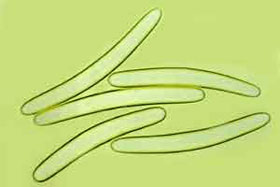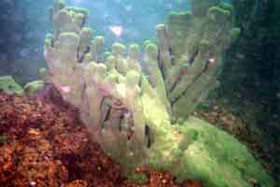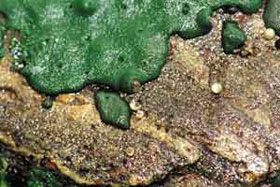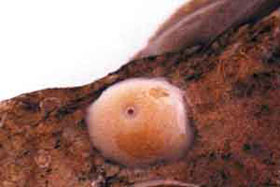Hello, Guest!
Zoological excursions
Spongers (Porifera)
|
Sponges-spongillidae |
A special world of sessile animals inhabits snags, large plants and other underwater objects not bothering about pursuit of a prey. In these areas it is possible to find brown or greenish crusts reaching some cm in diameter. Sometimes branches grow from these crusts. They are colonies of sponges-spongillidae (Spongilla lacustris). Sponges suck down water via the finest oscula and filter out nutritional particles – bacteria and microscopic algae. The sponge has a well-developed skeleton consisting of separate siliceous spicules. One can feel silicon if to grind a piece of sponge between fingers. In autumn, the sponge surface is covered with numerous golden-yellow balls – wintering gemmules.
Endemic Baikal sponges Lubomirskiidae belong to the silico-horny order Cornacuspongida. It is possible to see “forests” of sponges of bright-green colour in coastal waters. The sponge owes its colour to a microscopic alga – zoochlorella, which lives in sponge tissues in the zone where there is a lot of light. Sponges sampled from the depth are not of bright-green colour.
These animals dwell on stony substrates and have an attached mode of life. Sponges are of a very primitive organization. Their main activity is to continuously filter water via their body. Due to pulsation of numerous flagellate cells the water enters gemmules penetrating its surface. Then passing through the system of canals and chambers the water comes out. The sponge skeleton is formed of siliceous spicules the ends of which are attached to each other with an organic matter – sponging, which makes sponges more solid and stable. Sponges grow very slowly – 1-3 mm a year.
|
Spicules of Lubomirskia baicalensis |
Spicules of Swartschewskia papyracea |
|
Spicules of Baicalospongia |
|
The role of sponges in the Lake Baikal ecosystem can scarcely be overestimated. Experiments show that a sponge of 5-7 cm is able to filter 10-20 liters a day. These animals extract from the water nutritional particles (detritus, protozoa, bacteria, and algae), as well as dissolved mineral substances including silicon for construction of their skeleton. As Baikal sponges reach considerable sizes and form massive colonies at the bottom of the lake, their role in processes of biofiltration of near-bottom water is extremely important. Moreover, sponge colonies represent specific benthic communities. The whole sponge body including its base covering the stones is a shelter for the majority of other organisms. Both on the surface of sponges and inside them, it is possible to find crustaceans, larvae of chironomid midges, caddis-flies, worms, and other small animals.
|
Bushes of Lubomirskia baicalensis |
Colonies of Lubomirskia baicalensis |
A branchy sponge Lubomirskia baicalensis is a mass representative of sponges in Lake Baikal. This sponge does not inhabit the littoral zone. It prefers stones and rocks beginning from a depth of 1-1.5 m and can reach 1 m in height forming bushes at a depth of 10-15 m. They are well seen from a boat in calm weather. The sponge of the genus Baicalospongia does not develop branches. It forms massive crusts on stones and other hard objects in a form of glasses or bowls at a depth of 4 m and deeper. Swartschewskia papyracea occupies the littoral zone of open Baikal. They look like small whitish papillae and caps on the stones with 1-4 mm in diameter.
|
Bark-like sponge Baicalospongia |
Swartschewskia papyracea |
Copyright © 2005-2010 ЦНИТ ИГУ, 

Дизайн web-студия ЦНИТ ИГУ











